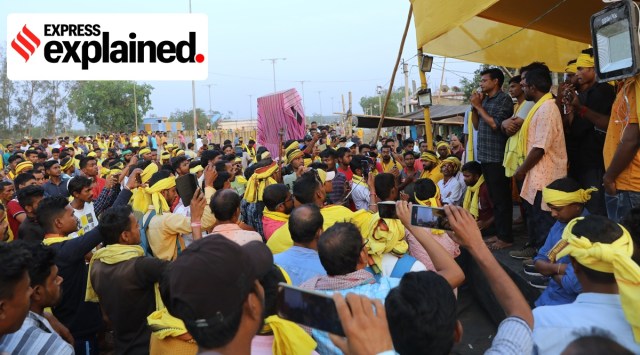After about a week of protests, the Kudmi community, which is demanding Scheduled Tribe (ST) status and the inclusion of their language in the Eighth Schedule of the Constitution, lifted their agitation following assurances from the West Bengal government. On Tuesday (April 11), some representatives met Chief Secretary Harikrishna Dwibedi in Kolkata.
The community had been sitting on protest in the Junglemahal areas of West Bengal and parts of Jharkhand. Last week, they blocked National Highways and railway tracks in Bengal’s West Midnapore and Purulia and some areas of Jharkhand for five days.

Who are the Kudmis?
Kudmis are mainly a peasant community, with their population concentrated in the Junglemahal areas or the Chota Nagpur plateau of West Bengal, Jharkhand and Odisha. Some Kudmis are also found in Assam and northern West Bengal, who have migrated from the Chota Nagpur plateau region. During the British rule, they were in the Scheduled Tribe or Aboriginal community list, and were regarded as a primitive tribe, like the Munda, Oraon, Bhumij, Kharia, Santhal, and others.
When were they excluded from the ST list?
After 1950, when the Scheduled Tribe list was prepared in independent India, Kudmis did not find a place on it. Ever since, they have been fighting for their identity as a Scheduled Tribe. The Kudmis argue that in the British era, various documents listed them as a tribe and an aboriginal community of India, and they want that identity restored.
Why they were excluded?
According to community members, during the British rule, some affluent Kudmis wanted to elevate their social status as “kshatriya” in the Hindu caste hierarchy, while other members opposed this “sanskritisation”. Khitish Mahato, professor of Gour College of Maldah and visiting professor of Jhargram University, said, “It is true that some Kudmis tried to change their identity to “kshatriya” during the British period. Not only Kudmis, many other adivasi communities participated in that movement.
But a majority of Kudmis still practise their traditional religion and lifestyle. Unfortunately, they were excluded from Scheduled Tribe list after independence. Now they are demanding their original identity. It is also true that, like other adivasi communities, their socio-economic condition has not changed.”
Story continues below this ad
Another section of the Kudmi population alleges that they were excluded from the ST list to show an increase in the population of the Hindu community.
What are their demands?
Over the past year, in West Bengal, Jharkhand and Odisha, an intensified movement has been witnessed by the Adibasi Kudmi Samaj and its allied organisations, mainly led by former Jharkhand Movement crusader Ajit Prasad Mahato. Mahato joined the Adibasi Kudmi Samaj in 2015 and organised a Durku Mahajuruahi (great gathering) at Tamna in Purulia, West Bengal, where over a lakh of people gathered to hear him.
Since then, the community has been vocally demanding inclusion in the ST list. Several social and political organisations also have emerged to champion the case, such as the Purbanchal Adibasi Kudmi Samaj, Kudmi Sena, Abga Kudmi Sena, Kudmi Samannay Samiti, Kudmi Unnayan Samiti, Kudmi Bikash Morcha, and United Kudumi Samaj.
Rajesh Mahato, president of the Adibasi Kudmi Samaj, said, “We want to clarify that our agitation is not for reservation. Our main demands are to include Kudmis in the ST list, include our language, Kurmali, in the Eighth Schedule of the Constitution, and recognise Sarna as our religion.”








































